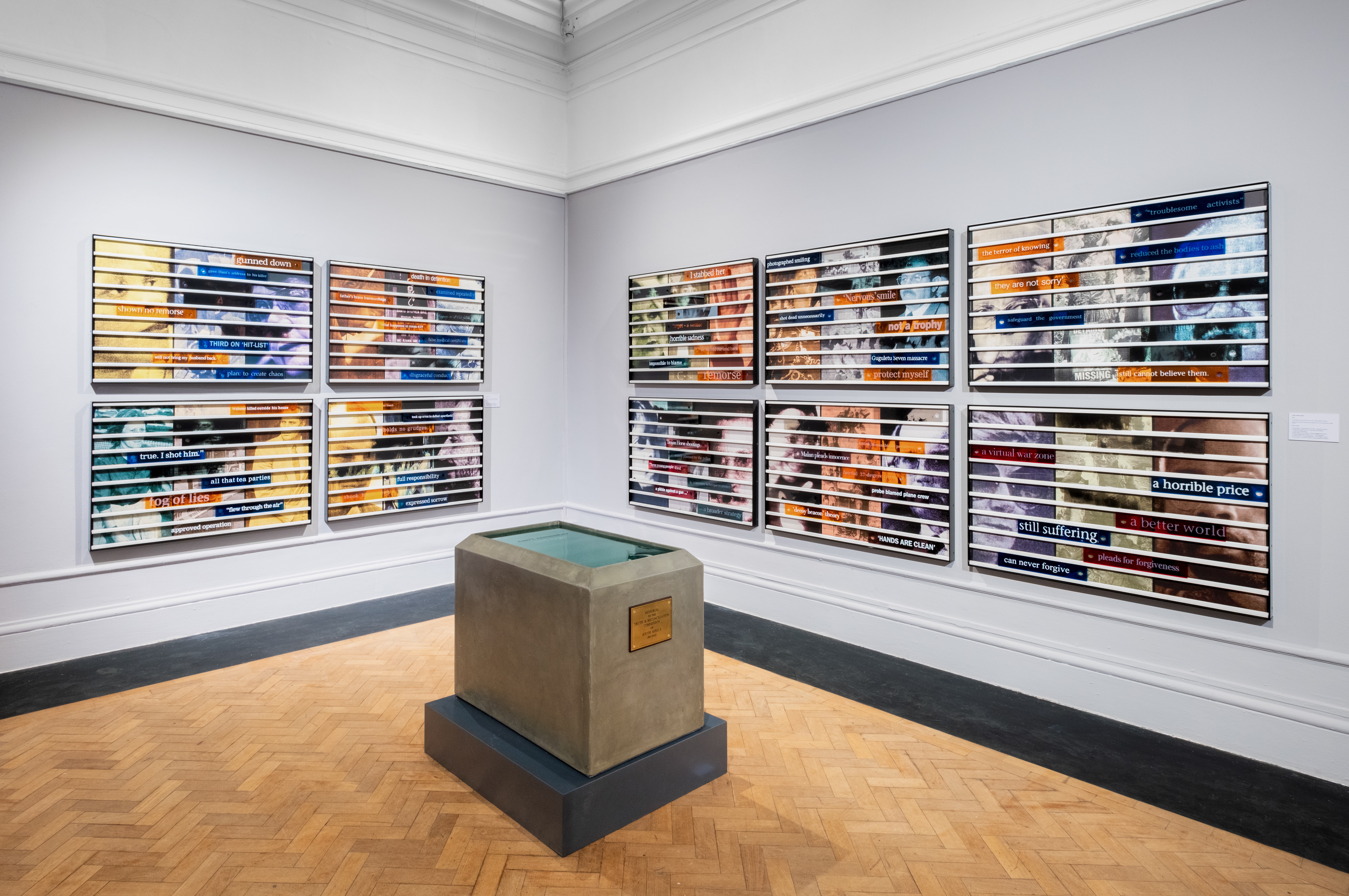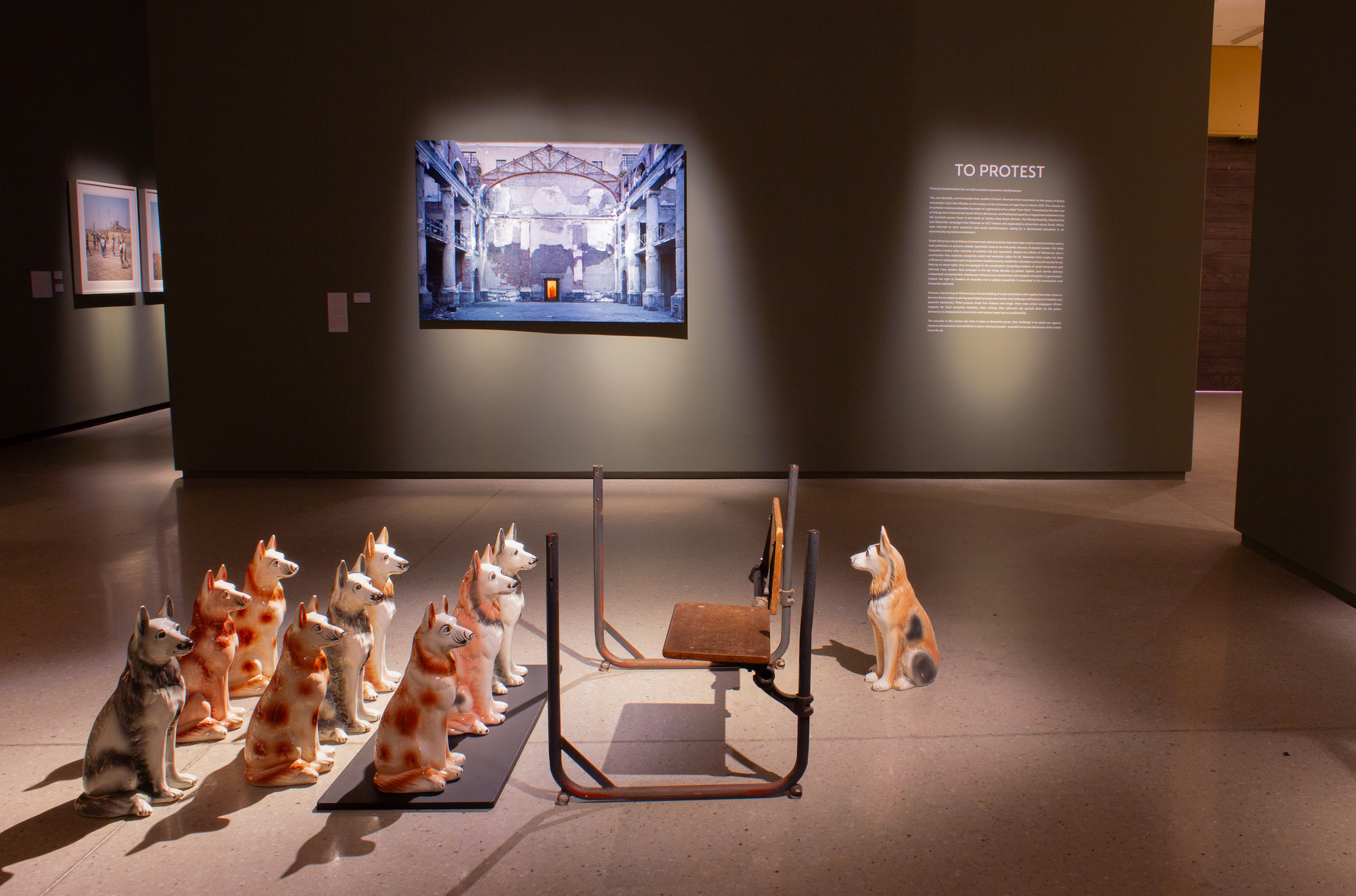Recording what the media can't
- By Mary Corrigall

Sue Williamson, Truth Games (detail shot), courtesy Iziko South African National Gallery
----------
The made-for-streaming HBO film Mountainhead, centred on a group of despicable billionaires gathering at one of their OTT lairs, was made in record time. Jesse Armstrong, the creator of Succession, pitched the concept in December last year, it was filmed in March and then released in May. There may have been financial benefits to its swift production. Still, largely the wide-held view is that the film company wanted to capitalise on the anti-billionaire sentiment that Elon Musk and Jeff Bezos had been generating via their various public-facing antics.
There is an expectation that art should reflect reality, but as the example of Mountainhead proves, what happens when the news cycle is likely to outpace art production and more significantly, what is the relationship between art and journalism in an age when traditional media has collapsed and has yet to find its feet in the digital era? In the South African context, where newsrooms and budgets have shrunk and there is no capacity to dig into meaty human-interest stories is there potential for visual artists to do so?
These questions are interesting to consider in light of two institutional exhibitions in Cape Town; We, The People, 30 Years of Democracy at the Norval Foundation, curated by Liese Van der Watt, and I have something to tell you, a retrospective on Sue Williamson at the Iziko SA National Gallery curated by Andrew Lamprecht. They are both survey shows reflecting on and depicting social and political struggles and shifts in South Africa, a well-worn lens through which the history of South African art has been analysed.
During the apartheid years – artists might have had more freedom than journalists to tell stories due to government press censorship, allowing them to boldly express conditions, realities, and human rights abuses that the media could not.

A Tale of Two Craddocks, by Sue Williamson, courtesy Iziko South African National Gallery
It was in a journalistic capacity that Williamson witnessed the forced removals in District Six and perhaps other locations, yet her work documenting the impact of it, The Last Supper (1981) (which appears in both survey shows) was staged towards the end of those events and is evoked through an installation of rubble from the destroyed buildings. In other words, it was a retrospective act, though it weighed through the evidence - almost scientifically in the glass-encased display of the detritus.
In looking at the nature of Williamson’s art and dates some of the works were produced, there is less sense that the works were intended to turn the tide of opinion or bring about change, but rather to ensure that the suffering and sacrifices that were made in the political struggle for democracy were recorded for posterity. In short, the art isn’t compelled by a journalistic compulsion – to immediately relay the facts with a short-lived impact in mind. In this way, while the journalistic mode – factual information is the grist to Williamson’s mill and she studied print media and photography in New York – her intentions and mode of delivery situate her as an artist. Her invention is in how she relays facts and makes her audience take notice of them in a meaningful way.
In the work For Thirty Years Next to his Heart (1990) Williamson assembles a grid of images of a man (Mr Ngesi) taking out his ‘passbook’ a document black people were forced to carry on their person to move freely and then the stamped pages in it. The pass-laws had been scrapped in the mid-eighties before this work was created.

We the People, Installation shot of viewers looking at images of Marikana, by Svea Jospehy, courtesy of Norval Foundation
Most of the works by Williamson relating to the apartheid era were created in the 90s – and come after the fact and perhaps fill in the gaps of knowledge and experiences that white people might have chosen to ignore or had little awareness of due to racial divisions. This may account for the thread of duality that runs through this exhibition, where two views are juxtaposed.
As Lamprecht observed in reference to the title of the survey, Williamson’s practice has pivoted on dialogue – the exchange of different views via multiple voices – this is often visually represented.
In A Tale of Two Cradocks (1994), a concertina display shows tourist-friendly images of Eastern Cape Town from one side. If you approach it from the other, the tragic story of the death of the political activist Matthew Goniwe is documented. As such, her art has an interesting relationship to the journalist ethos of presenting two different views, albeit perhaps the intended message is predetermined.
This blurred line between art and journalism naturally resurfaces at the We the People, 30 Years of Democracy exhibition, largely in photographic works by the usual suspects from David Goldblatt via images of black South Africans attaining ‘freedoms’ of the new era from a woman planting veggies to a man building a house, to an image of prisoner voting by Mikhael Subotzky, to Pieter Hugo's images of a poor white couple with a young black boy, to Svea Josephy’s images of the site where the Marikana tragedy took place.
 We the People, Installation shot, courtesy of Norval Foundation
We the People, Installation shot, courtesy of Norval Foundation
Tellingly, in these examples it is white artists capturing the lives of black people perhaps guided by the idea that democracy entailed connecting with and shifting attention to the ordinary people who had suffered during apartheid. The medium of photography with its connection to journalism is responsible for this focus if you consider the work of prominent black photographers - Zanele Muholi, Ashley Walters, Jabulani Dlamini and Sabelo Mlangeni,Thabiso Sekgala and Sobekwa Lindokuhle - whose works in this exhibition also embraces a documentary mode and speaks to another generation interested in exploiting journalistic enquiry.
In this way photography plays a role in gauging Democracy’s ‘success’ , providing verifiable records to measure the fate of South Africa’s majority in the hands of a new political dispensation.
This is not only limited to photography - video works by Moshekwa Langa depicting people climbing into a bus and Steven Cohen's contentious performance in a squatter camp drive this journalistic compulsion to tell the stories of the marginalised or oppressed. However, even abstract works on this exhibition, such as Nicholas Hlobo's ribbon, leather and thread composition on canvas titled Intlambo Yochulumanco are framed via texts near the work to be representative of his experience of "being a gay man in a Xhosa culture". There is a sense that the social context underpinning art in South Africa relates to its value and there is a prevailing morality underpinning art.
This sharply contrasts with the democratisation of art through the art fair model, which has popularised it among different social and economic groups, leading to its commodification and less need for a social or political imperative. The new middle class is naturally keen to view their comfortable lives depicted in art manifesting most prominently in images of black people at leisure which recurred in the portraiture trend informing the late Koyo Kouoh's When We See Us: A Century of Black Figuration in Painting – a narrative arc in the post-apartheid era that is absent in We, the People.
A psychic and generational shift has occurred since democracy around why and how artists make work, they are more empowered to tell their own story rather than speak for the "people". In this way the political is told through a personal lens and is rooted in the first person so to speak in literary terms.
This is reflected in the final gallery display of We the People, where all myriads of subject-matter, subjectivities are encompassed such as a work by Tom Cullberg, a Swedish artist, whose installation of paintings document a nostalgia for another time, era, place in the face of rapid change. This cultural-turn is maybe rooted in an awareness of cultural appropriation, hyper individualism that late capitalism has inculcated but also has to do with a society that is not facing an obvious violent political conflict or an erosion of human rights. Without the freedom of expression art cannot flourish and becomes co-opted into a dialogue with a repressive state.
This psychic gap between generations comes to the fore in Williamson's titular documentary filmic works capturing the dialogue between political activists from the apartheid era and their grandchildren. The exchanges are fraught with resentments and show the gaps between the apartheid and post-apartheid generations. In the dialogue between Amina and Luiza Cachalia, Luiza is angry that her grandmother has never communicated the grief and anguish of living in the apartheid era and the high personal cost of fighting it. Amina suggests that to do so would have meant to relinquish the battle. It becomes clear that all the suppressed emotions from one generation were passed on to another and that there is still much to uncover and air from our fraught history.
Ultimately, what artists such as Williamson are able to do, are to bring us the facts, but also create a space for the silences between them to come to light, fusing the best of features of journalism and art.
Corrigall is a Cape Town based art commentator and consultant and director of the HEAT Winter Arts Festival.
Further Reading In Articles
African Artist Directory















